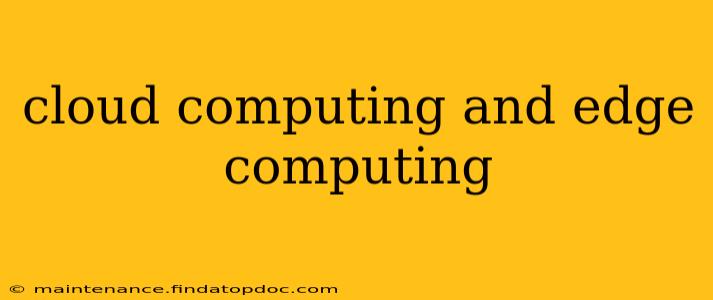The digital world is increasingly reliant on the seamless processing and delivery of data. Two key technologies driving this evolution are cloud computing and edge computing. While often discussed together, they represent distinct approaches with unique strengths and weaknesses. This comprehensive guide explores the core differences between cloud computing and edge computing, highlighting their respective applications and the scenarios where each excels.
What is Cloud Computing?
Cloud computing is a model for delivering IT services—including servers, storage, databases, networking, software, analytics, and intelligence—over the Internet (“the cloud”). Instead of owning and maintaining your own computing infrastructure, you access these resources on an as-needed basis from a cloud provider like Amazon Web Services (AWS), Microsoft Azure, or Google Cloud Platform (GCP). This model offers scalability, flexibility, and cost-effectiveness, making it ideal for a wide range of applications.
Key Characteristics of Cloud Computing:
- Centralized Data Storage and Processing: Data is primarily stored and processed in large data centers located far from the end-users.
- High Scalability and Flexibility: Resources can be easily scaled up or down depending on demand.
- Cost-Effectiveness: Users only pay for the resources they consume, reducing upfront capital expenditures.
- Accessibility: Data and applications are accessible from anywhere with an internet connection.
What is Edge Computing?
Edge computing, in contrast, brings computation and data storage closer to the source of data generation. Instead of relying on a centralized cloud, processing happens at the "edge" of the network, closer to the devices generating the data (e.g., IoT sensors, smartphones). This proximity significantly reduces latency and bandwidth requirements.
Key Characteristics of Edge Computing:
- Decentralized Processing: Data is processed closer to the source, minimizing latency.
- Reduced Bandwidth Consumption: Less data needs to be transmitted to the cloud, saving bandwidth and costs.
- Improved Real-time Capabilities: Enables faster response times crucial for real-time applications.
- Enhanced Data Security: Data remains closer to the source, potentially reducing security risks associated with data transmission.
Cloud Computing vs. Edge Computing: A Detailed Comparison
| Feature | Cloud Computing | Edge Computing |
|---|---|---|
| Location | Centralized data centers | Distributed at the network edge |
| Latency | Higher | Lower |
| Bandwidth | Higher | Lower |
| Scalability | Highly scalable | Scalability depends on edge infrastructure |
| Cost | Pay-as-you-go model, potentially lower upfront costs | Higher initial investment, lower ongoing costs (potentially) |
| Security | Centralized security measures | Decentralized security measures, potential vulnerabilities |
| Applications | Web applications, data analytics, storage, etc. | IoT, real-time analytics, autonomous vehicles, etc. |
What are the benefits of using cloud computing?
Cloud computing offers numerous benefits, including:
- Cost savings: Eliminates the need for large upfront investments in hardware and infrastructure.
- Scalability and flexibility: Resources can be easily scaled up or down to meet changing demands.
- Increased efficiency: Streamlines IT operations and automates many tasks.
- Enhanced collaboration: Enables teams to collaborate more effectively on projects.
- Improved disaster recovery: Provides backup and recovery options to protect against data loss.
What are the benefits of using edge computing?
Edge computing provides several key advantages, especially in scenarios demanding low latency and high bandwidth efficiency:
- Reduced Latency: Faster processing and response times are critical for real-time applications.
- Improved Bandwidth Efficiency: Processing data locally reduces the amount of data transferred to the cloud.
- Enhanced Security: Keeping data closer to the source can reduce security risks.
- Offline Functionality: Enables applications to function even when network connectivity is limited or unavailable.
- Support for Real-Time Applications: Ideal for applications demanding immediate responses, such as autonomous vehicles and industrial automation.
When to use Cloud Computing and when to use Edge Computing?
The choice between cloud and edge computing depends largely on the specific application requirements.
-
Choose Cloud Computing when:
- High scalability and flexibility are required.
- Cost-effectiveness is a primary concern.
- Data processing does not require extremely low latency.
- Data security is managed effectively by the cloud provider.
-
Choose Edge Computing when:
- Low latency is critical (e.g., autonomous driving, industrial control).
- High bandwidth consumption needs to be minimized.
- Real-time processing is essential.
- Data security requires keeping data closer to its source.
The Future of Cloud and Edge Computing: Convergence and Collaboration
Rather than seeing cloud and edge computing as competing technologies, the future points towards a collaborative approach. Many organizations are adopting hybrid models that leverage the strengths of both cloud and edge computing. This integration allows for optimal data processing and storage, combining the scalability of the cloud with the low latency and responsiveness of the edge. This hybrid approach will likely become increasingly prevalent as data volumes continue to grow exponentially.
